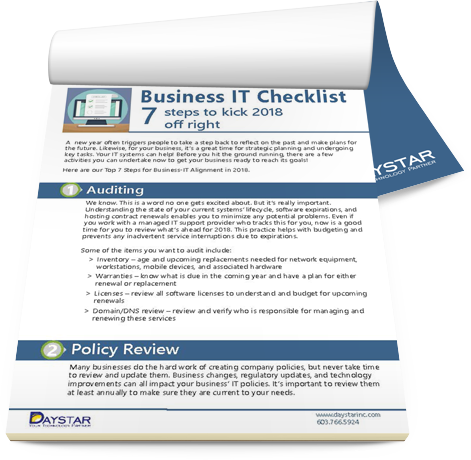If the last two years have taught us anything, it’s that our reliance on technology is only going to grow. Technology is critical to business operations. Planning, vetting, procuring, implementing, maintaining, troubleshooting, and securing a business’ IT infrastructure is no small task. While you may have an IT person on staff, or even a small internal IT department of a few people, it may be difficult to keep all your technical bases covered. More and more, we are seeing companies adopt a co-managed IT support partnership with a trusted managed IT services provider (MSP).
Businesses of all shapes and sizes, from the small dental practice to the financial services firm to the manufacturing floor, have integrated new technologies over the past few years that change how, where, and when we work. Remote work tools break the boundaries of the traditional office space, while creating new cybersecurity concerns. Automation technologies increase efficiencies, while aiding some industries affected by workforce shortages. Likewise, businesses’ IT support needs have also grown increasingly sophisticated.
 Whether it is organic growth of the organization, or the need for increasingly sophisticated tools, fully supporting a business’ IT infrastructure requires more than just a technician who can fix the printer or an engineer who can set up your WiFi. It involves various skill sets to address all your IT components: IT planning, budgeting, and documentation; solution vetting, procurement, and vendor management; IT implementation and integration; network management and maintenance; end user support and troubleshooting; and network monitoring and cybersecurity controls. Internal IT teams have a lot on their plate.
Whether it is organic growth of the organization, or the need for increasingly sophisticated tools, fully supporting a business’ IT infrastructure requires more than just a technician who can fix the printer or an engineer who can set up your WiFi. It involves various skill sets to address all your IT components: IT planning, budgeting, and documentation; solution vetting, procurement, and vendor management; IT implementation and integration; network management and maintenance; end user support and troubleshooting; and network monitoring and cybersecurity controls. Internal IT teams have a lot on their plate.
Challenges for In-house IT Teams
Internal IT teams are as varied as the businesses they support. The smallest businesses may simply designate an employee they deem the most “techie” to handle IT. Other small and midsized businesses may hire an IT manager and may even grow to have several IT professionals on staff. Regardless of how they are configured, the technology demands of today’s modern businesses present many challenges and stressors on internal IT teams.
As you might infer from the long list of IT components listed above, competing priorities is a common hurdle for internal IT. They must constantly balance strategic priorities, technology initiatives, and end user support. While balancing workload is not unique to IT teams, the way the rest of the organization relies on this department is.
Virtually every single member of your organization relies on your IT person or team to do their job. End user support will always trump other responsibilities, understandably. However, while your IT people are busy resolving technical problems, other things are delayed or simply not done. There are a lot of moving parts to IT. It’s not uncommon to see critical tasks like auditing or network maintenance get delayed or put on hold in the face of more time pressing issues. Likewise, delayed strategic projects are usually the very things your business needs to move forward efficiently.
Another challenge for internal IT stems from the increasing complexity of technology systems and access to sensitive data. The IT person setting up the workstation for your new staff member has a different skill set from the IT security engineer managing your cyber defense tools. And a comprehensive IT support system needs all those skill sets. Various disciplines are required, including help desk support, network infrastructure management, cloud integration, cybersecurity, etc. Likewise, the components listed previously depend on numerous character traits that can’t be found in one or two people. It’s not feasible for SMBs to staff for all the expertise and traits needed. As a result, internal IT teams often identify skills gaps that hold them back from doing everything they want to do to support the business.
In addition to skill sets, there is also the question of backups or reserves. Many internal IT people work on an island of sorts. They are often the only person in the organization that can perform the job and understands the business’ IT environment. This puts a lot of stress on your employee or staff who may feel unable to take vacations or use personal time. In addition, this puts the business at risk. If your IT person is suddenly unavailable, e.g. the proverbial “hit by a bus” scenario, or decides to leave the company, how confident are you in the stability of your IT and business operations?
Lack of access to IT automation and network management tools can also be an obstacle for internal IT teams. These tools are designed to create efficiencies with automated processes and proven structures. However, they are also quite expensive. Businesses whose focus is not on technology would have a hard time justifying the cost. Still, this means that in-house IT teams make do with more manual and time-consuming processes.
The dizzying pace of change in technology is a common challenge for all IT professionals. However, for the internal IT person juggling all IT tasks for the organization, it is nearly impossible to stay on top of new developments and trends in technology that could ultimately help your business. They are working extremely hard keeping their head above water! This often prevents you from getting the most out of any line-of-business software (LoB) investments you make as well.
LoB software are those applications that are specific to your industry. For example, manufacturers might use SAP, SYSPRO, Oracle, NetSuite, or Fishbowl. Health care organizations have specialized applications for electronic medical records, e-prescribing software, and more. As many applications are now cloud-based, these systems are updated on a continuous basis. When your internal IT resources are focused on the daily trouble tickets and immediate network management concerns, they are left with no time to vet and implement new improvements and capabilities that can benefit the business.
The final challenge internal IT teams face is staffing. Here in the northeast, many businesses face HR headaches with workforce shortages. Hiring an IT professional, however, has long been a struggle. Recruiting, training, managing, and retaining IT talent is extremely competitive and expensive. Your small business is competing with enterprise-level companies, as well as dedicated tech companies that might be more attractive to a young IT professional.
 These six challenges – competing priorities, skill gaps, solo team of one, manual IT processes and systems, keeping up with technology changes, and staffing – put your IT team in an unwinnable situation. Mistakes and oversights are more common which ultimately impact efficiency and revenue. However, the biggest downside is on your people. IT professionals are smart, curious problem solvers. If they lack access to the resources and systems they need to perform the level of IT support they want, it can lead to frustration, burnout, and churn.
These six challenges – competing priorities, skill gaps, solo team of one, manual IT processes and systems, keeping up with technology changes, and staffing – put your IT team in an unwinnable situation. Mistakes and oversights are more common which ultimately impact efficiency and revenue. However, the biggest downside is on your people. IT professionals are smart, curious problem solvers. If they lack access to the resources and systems they need to perform the level of IT support they want, it can lead to frustration, burnout, and churn.
What is Co-managed IT Support?
Businesses who handle IT inhouse value the accessibility and speed of having IT resources on staff. In addition, no one can understand how your business operates better than an internal employee. Their institutional knowledge is extremely valuable to your IT strategy. To combat the lack of resources and time constraints plaguing small internal IT teams, some businesses choose to supplement their internal resources with outside support.
Co-managed IT support is a collaborative, partnership-based approach to IT support. Your internal IT team works in tandem with an external IT provider, often an MSP, to co-manage and maintain your technology environment and IT support system. It combines the internal insight and convenience of an inhouse team with the additional expertise, tools, and resources of an outsourced IT services provider.
So, how does it work? First, you need to determine what your team and business needs based on either the strengths of your internal team and/or the challenges they currently face. A major benefit to co-managed IT arrangements is how customizable they are. You may want your team focused on end user support and use your IT partner to handle network management, IT roadmap strategy, and cyber security. Or you could dedicate your internal team to maximizing your LoB software implementations and task your IT provider with the additional end user support.
Once you have determined your business needs, you can then create a co-managed IT plan with your chosen MSP. The plan should be documented with well-defined responsibilities and objectives. Metrics should be identified and tracked as well. Your co-managed IT team will then work hand in hand on executing your business’ IT support plan.
Co-managed IT is a scalable, agile relationship that can change over time as needs morph. It is an alliance between your staff and your outsourced IT partner and extends the capacity of your IT team with additional technical expertise, access to sophisticated IT management tools, and more IT resources without the additional overhead.
Internal + Outsourced IT = Co-managed IT Support that Benefits your Business
Co-managed IT support removes obstacles from your inhouse team and provides access to the resources your business needs to move further toward its goals. It’s a win-win situation for your IT staff and the business. The benefits of this arrangement include:
- Extended IT Expertise: A co-managed IT partner gives access to specialized resources so you can address any current skills gaps e.g., cybersecurity, cloud integration, etc.
- Inhouse Control: Retain control over IT operations internally with your IT staff managing the partner relationship and creating a co-managed plan that works best for your business.
- Prioritized Focus: Removing competing priorities and setting defined focus areas increases the overall productivity of your entire IT support system, from frontline support all the way to strategic IT planning.
- IT Management Tools: Access to industry-standard IT automation and management tools helps your IT team support your employees faster, enhance network stability and security, and automate processes.
- Employee Appreciation and Fulfillment: Providing support for your team helps to reduce frustration and burnout and promote engagement and satisfaction that aids in employee retention.
- Cost Savings: In relation to hiring more IT staff or doing nothing and suffering through the productivity and burnout challenges that follow, a co-managed IT services contract is much more cost-efficient while also providing you with a deep bench of resources and skill sets.
- 24/7 IT Support: Many IT partners offer access to around-the-clock remote end user support so that your team isn’t help back with tech issues whenever or wherever they are working.
- Competitive Advantage: A co-managed IT relationship enables you to stay on top of trends and changes so you can implement the right technology solutions that will keep your business either current or ahead of your competitors.
- Increased Cybersecurity: Using your co-managed IT partner’s advanced cybersecurity controls provides more confidence against cyber threats, and visibility into your business’ data protection and integrity.
Whether you are an IT manager for a business and are feeling held back by outside forces, or a business owner who suspects their inhouse team could use some support, consider whether a co-managed IT support partnership might alleviate some ongoing challenges and equip your IT team with the resources and tools necessary to help the business reach its goals.
For more information on Daystar’s co-managed IT plans, contact us today.















